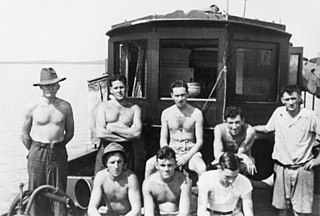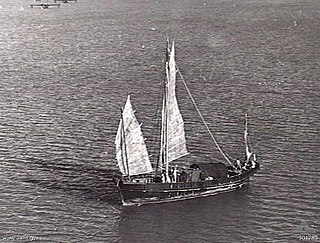A folding kayak is a direct descendant of the original Inuit kayak made of animal skins stretched over frames made from wood and bones. A modern folder has a collapsible frame made of some combination of wood, aluminium and plastic, and a skin made of a tough fabric with a waterproof coating. Many have integral air chambers inside the hull, making them virtually unsinkable.

Garden Island is a narrow island about 10 kilometres (6 mi) long and 1.5 kilometres (0.9 mi) wide, lying about 5 kilometres (3 mi) off the Western Australian coast, to which it is linked by an artificial causeway and bridge.

Operation Jaywick was a special operation undertaken in World War II. In September 1943, 14 commandos and sailors from the Allied Z Special Unit raided Japanese shipping in Singapore Harbour, sinking six ships.

Z Special Unit was a joint Allied special forces unit formed during the Second World War to operate behind Japanese lines in South East Asia. Predominantly Australian, Z Special Unit was a specialist reconnaissance and sabotage unit that included British, Dutch, New Zealand, Timorese and Indonesian members, predominantly operating on Borneo and the islands of the former Dutch East Indies.

Operation Rimau was an attack on Japanese shipping in Singapore Harbour, carried out by an Allied commando unit Z Special Unit, during World War II using Australian built Hoehn military MKIII folboats. It was a follow-up to the successful Operation Jaywick which had taken place in September 1943, and was again led by Lieutenant Colonel Ivan Lyon of the Gordon Highlanders, an infantry regiment of the British Army.

The Snake-class junks were a class of six small vessels operated by the Royal Australian Navy (RAN) to support special forces operations in 1944 and 1945. The ships were lightly armed and were used to infiltrate special forces parties and their supplies into Japanese-held territory.
Operation Python was carried out by the Allied commando unit Z Special Unit, during World War II. The objective of the mission was to set up a wireless station near Labian Point in North Borneo and undertake covert operations reporting on the sea lane of the Imperial Japanese Navy in the Sibutu Passage and the Balabac Strait of the Sulu Sea. The operation was split into Python I and Python II.

The Z Experimental Station (ZES) was established in July 1942 at Munro Terrace, Mooroobool, Cairns, Queensland, Australia, jointly by Secret Intelligence Australia and the Inter-Allied Services Department. The building chosen to be the headquarters was known as "Fairview", and it had been the home of Richard Ash Kingsford, the first mayor of Cairns and grandfather of aviator Sir Charles Kingsford Smith.
HMAS Sea Snake was an auxiliary Snake-class junk built for the Royal Australian Navy during the Second World War. She was launched in 1945 and commissioned into the Royal Australian Navy on 31 March 1945. She was used by the Services Reconnaissance Department and was paid off on 27 November 1945, before being handed over to the British Civil Administration in Borneo.

HMAS Tiger Snake was a Snake-class junk built for the Royal Australian Navy during the Second World War. She was launched in 1945 and commissioned into the Royal Australian Navy on 22 August 1945 and was used by the Services Reconnaissance Department (SRD).

HMAS River Snake was a Snake-class junk built for the Royal Australian Navy during the Second World War. She was launched in 1945 and commissioned into the Royal Australian Navy on 19 February 1945. She was used by the Services Reconnaissance Department (SRD) and was paid off on 2 November 1945, before being handed over to the British Civil Administration in Borneo.
HMAS Grass Snake was a Snake-class junk built for the Royal Australian Navy during the Second World War. She was launched in 1945 and commissioned into the Royal Australian Navy on 23 April 1945.

Operation Copper was carried out by the Allied commando unit Z Special Unit, during World War II. The objective of the mission was to investigate the Japanese defences on Muschu Island, capture a Japanese officer for interrogation and discover the location of two naval guns on the island that covered the approaches to Wewak Harbour. Eight commandos were landed as part of the operation; only one survived.

Operation Semut was a series of reconnaissance operations carried out by Australia's Z Special Unit in 1945, during the final stages of World War II. This operation was the part of the Borneo Campaign, and was undertaken in Sarawak, northwestern Borneo, in support of Allied operations to secure North Borneo. Another closely related operation codenamed Agas was carried out concurrently in North Borneo. Both operations combined and relayed their intelligence through the Stallion Project to Australian forces and carried out guerrilla warfare against the Japanese in the region with the full support of the local population. A total of four operations were undertaken under the auspices of Operation Semut, concluding in September and October 1945.
Operation Scorpion was a proposed operation in World War II by Australia's Z Special Unit.
Operation Hornbill was a proposed commando operation by Australian forces during World War II.
Operation Sunlag was an Australian military operation in Timor during World War II. Its aim was to investigate what happened to Operation Lagarto.
Operation Lizard was the name given to a series of operations undertaken in Portuguese Timor by Australian troops in World War Two using Hoehn military folboats to get from the vessel to the island and return.
Operation Platypus was an operation by Allied special reconnaissance personnel from Z Special Unit during the Borneo Campaign of World War II. Platypus involved small groups being inserted into the Balikpapan area of Dutch Borneo (Kalimantan), to gather information and organise local people as resistance fighters against the Japanese.
Operation Walnut was a military operation conducted by the Allies, notably the Netherlands East Indies Forces Intelligence Service, on the Aroe Islands during World War II. It took place in three phases:









